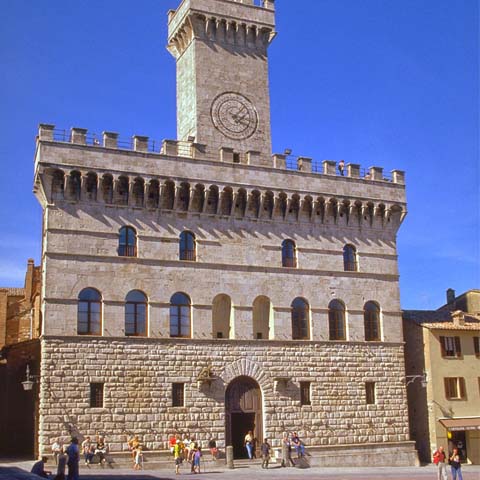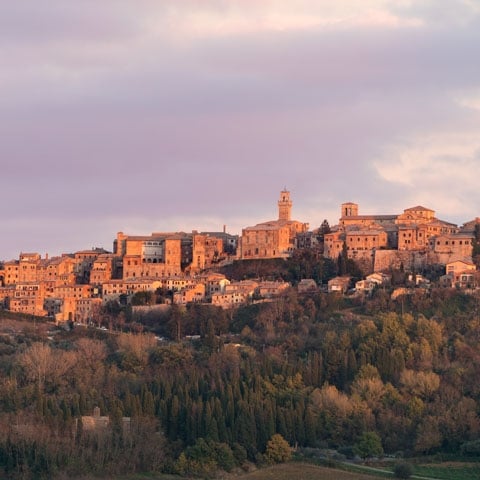The hilltop town of Montepulciano tucked away in the heart of Tuscany is well-known for its breathtaking surroundings and esteemed Vino Nobile di Montepulciano wine. Located in the province of Siena, the center of town features medieval and Renaissance architecture surrounded by fourteenth century defensive walls.
Montepulciano’s history begins with the Etruscans. During the Middle Ages, the town was passed between the Sienese and Florentine powers. Today, Montepulciano is a revered travel destination, and the perfect place to enjoy wine tasting while surrounded by Tuscany’s legendary atmosphere.
PREHISTORY OF MONTEPULCIANO
The history of Montepulciano is linked to its geographical location. It is situated among the Val di Chiana, Val d ‘Orcia, and Trasimeno areas as well as on the border of three medieval areas of influence: Orvieto, Perugia, and Siena.
Due to this strategic position, Montepulciano was of interest to the cities always in conflict with each other during that period. The exact origin of the first settlements is not known, but according to historians it was certainly inhabited already in Etruscan times.
According to legend, Montepulciano was founded by the famous Etruscan King Porsenna di Chiusi, who was known for his war against the city of Rome.
HISTORY OF MONTEPULCIANO
A local document dating back to the ninth century refers to clerics, doctors and goldsmiths. This is a sign of notable social stratification and high civil and cultural development in the city.
For a long time, Montepulciano was in the crosshairs of both Siena and Florence with numerous wars and battles as a result.
In 1232, the Sienese destroyed the city walls and managed to take Montepulciano. For about three centuries, the city alternated between Sienese and Florentine orbit.
The local merchant, manufacturing and agricultural bourgeoisie increased their power thanks to trade. The city was enriched and enlarged. The families of the merchant bourgeoisie were skilled in supporting Florence, Siena or Perugia in alternate phases, according to their interests.
The fourteenth century marked a period of great prosperity for Montepulciano. Mercantile activities developed and intensified, while the town’s central position favored the transport of goods. Internal trade of agricultural products was also lively.
It was during this time that the city’s urban planning developed around the markets. However, the internal conflicts between the noble families persisted.
In 1390, Montepulciano made a permanent alliance with Florence.
From the beginning of the fifteenth to the middle of the sixteenth century, Montepulciano was characterized by political stability, cultural prestige, and artistic flourishing. Artists and architects worked there and the urban layout was revised with the construction of impressive public buildings, churches, and noble palaces.
Important church figures as well as illustrious writers and artists lived in Montepulciano during this period. In 1561, Montepulciano became a bishopric seat and the Cathedral was built thanks to Cardinal Giovanni Ricci. In 1600, architectural works continued and several churches were erected.
From 1609 to 1636, Montepulciano was governed by the Grand Duchess Cristina di Lorena, granddaughter of Caterina de Medici. The Grand Duchess was intelligent, cultured, and offered patronage to philosophers and scholars.
The cultural vitality of the Montepulciano noble family continued in the following century. In 1796, the Poliziano Theater was built.
During the nineteenth century, the reclamation of Val di Chiana led to an increase in the town’s population as well as the population of the surrounding area.
In 1844, the construction of the railway line favored the downstream displacement of the commercial axis. Many businesses “moved outside the city” during this period. Still, Montepulciano maintained its importance as an administrative, agricultural, and product processing center.
Like many other towns in the Val di Chiana and throughout Italy, Montepulciano was severely hit by the events of World War I and World War II, up to the liberation from the Nazi-Fascist occupation.
When World War II concluded, almost all the towns of the Val di Chiana suffered intense depopulation with many locals moving to the north in search of work.
The 1960s brought the so-called economic boom, and the local economy resumed. This gave new vigor to agricultural activities and viticulture.
In 1984, Montepulciano passed from the province of Arezzo to that of Siena.
Today, tourism is a key segment of the local economy, favored by the naturalistic beauty of the area.
ARCHEOLOGY IN MONTEPULCIANO
Montepulciano’s Cruciani Gallery – Civic Museum features a section dedicated to archeology. The findings are of considerable aesthetic value, in addition to testifying the importance of the Val di Chiana as a road junction since ancient times. They also demonstrate the widespread well-being of the area. The most prestigious objects are the bronze artifacts, including the precious foculo — a sort of brazier — and a candelabrum.
The museum also displays Etruscan tomb artifacts and finds from Ancient Roman buildings. In addition, some Etruscan cinerary urns from the collection of the noble Poliziano Pietro Bucelli are visible. Worthy of note is the grandiose Etruscan stone door, used until Roman times as an entrance to a burial site.
Montepulciano’s Fortress is a place of great historical and cultural value. The oldest records date back to the eighth century and speak of the Castrum Politianum, located in a strategic position to defend the city and observe the movements of enemies in the surrounding valleys. Even before the Lombard period, however, the castrum was probably used as a city fortification. During restoration works in 2014, a stone wall measuring 18 feet in diameter was discovered with artifacts from the Etruscan and Roman times.
Nearly 20 miles south of Montepulciano is the Mount Cetona Civic Museum for Prehistory, which documents human settlement in the territory around Mount Cetona from the Paleolithic to the end of the Bronze Age. The prehistoric events of the area begin in the Middle Paleolithic: Neanderthal man inhabited some Cetona caves, leaving chipped stone tools and remains of hunted animals as a trace of his passage. After a sporadic attendance during the Neolithic and the Copper Age, there was intense population during the second millennium BC, especially in Belverde, on the eastern side of the mountain, where man erected huts, inhabited the shelters under the rock, and buried their dead. A rich archaeological documentation remains of this phase which constitutes the main nucleus of the museum. The itinerary ends with a space reserved for temporary exhibitions.
The Belverde Archeodrome, located not far from the archaeological area of the same name, is an educational path created to complete and integrate the visit to the Museum and the Park. The settings, structures and artifacts reproduced are inspired by the two phases of prehistory best documented in this territory.
Chiusi, not far from Montepulciano, offers an interesting archaeological, historical and artistic panorama related to the territory. The National Etruscan Museum, the Cathedral Museum and the Civic Museum in Chiusi display finds from archaeological excavations.
Established in 1871, the Etruscan Museum was moved to its current Neoclassical building in 1901. Here visitors can see laminated bronzes, decorations, statues and reliefs made of sulphureous stone as well as sarcophagi and urns made of clay and alabaster. There are also significant imported products, such as painted Greek vases. The statue of Augustus, considered one of the most refined portraits of the emperor, stands out for its beauty among the other Roman statues.
In addition to the Etruscan museum, the Etruscan tombs are another archaeological treasure of Chiusi. Among these is the Tomb of the Pilgrim, which was dug in natural sandstone and still preserves sarcophagi and urns. The most famous is the Tomb of the Monkey, which is believed to have originated in the fifth century B.C. In addition to the burial beds, the tomb features wall paintings and a coffered ceiling.
Another archaeological jewel is the Labyrinth of Porsenna. It is a network of tunnels used in Etruscan times as a water supply system that was later abandoned.
Don't just see Italy, live it.
Your dream trip to Italy has never been closer
No more endlessly scrolling travel sites. Our travel experts will craft the perfect, one-of-a-kind trip just for you.

300+
DESTINATIONS
We offer more Italian destinations than any travel site. Do and see more with Trips 2 Italy.
1 (of a kind)
ITINERARIES
Because your dream trip to Italy should be designed for you, not for the masses.
100%
PEACE OF MIND
From flights and accommodations, to food and activities - we take care of every detail.
















